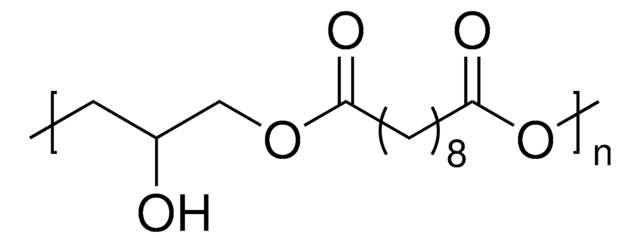84809
Sebacic acid
≥95.0% (GC)
Synonym(s):
Decanedioic acid
Sign Into View Organizational & Contract Pricing
All Photos(1)
About This Item
Linear Formula:
HO2C(CH2)8CO2H
CAS Number:
Molecular Weight:
202.25
Beilstein:
1210591
EC Number:
MDL number:
UNSPSC Code:
12352100
PubChem Substance ID:
NACRES:
NA.22
Recommended Products
vapor pressure
1 mmHg ( 183 °C)
Quality Level
Assay
≥95.0% (GC)
bp
294.5 °C/100 mmHg (lit.)
mp
133-137 °C (lit.)
functional group
carboxylic acid
SMILES string
OC(=O)CCCCCCCCC(O)=O
InChI
1S/C10H18O4/c11-9(12)7-5-3-1-2-4-6-8-10(13)14/h1-8H2,(H,11,12)(H,13,14)
InChI key
CXMXRPHRNRROMY-UHFFFAOYSA-N
Looking for similar products? Visit Product Comparison Guide
Storage Class Code
11 - Combustible Solids
WGK
WGK 1
Flash Point(F)
Not applicable
Flash Point(C)
Not applicable
Personal Protective Equipment
dust mask type N95 (US), Eyeshields, Gloves
Choose from one of the most recent versions:
Already Own This Product?
Find documentation for the products that you have recently purchased in the Document Library.
Customers Also Viewed
A Bertuzzi et al.
Biochemical pharmacology, 45(3), 697-702 (1993-02-09)
Sebacic (decanedioic) acid is a dicarboxylic acid proposed recently as an alternative energy substrate in total parenteral nutrition. In this paper, binding of sebacic acid to defatted human plasma albumin, also in the presence of decanoic acid, was studied by
Christiane L Salgado et al.
Tissue engineering. Part A, 18(1-2), 137-146 (2011-09-10)
Tissue engineering constitutes a promising alternative technology to transplantation medicine by creating viable substitutes for failing tissues or organs. The ability to manipulate and reconstitute tissue function has tremendous clinical implications and will most likely play a key role in
Easy fabrication and morphology control of supramolecular liquid-crystalline polymer microparticles.
Hui Liu et al.
Macromolecular rapid communications, 32(4), 378-383 (2011-03-25)
A novel kind of supramolecular liquid-crystalline polymer (SLCP) microparticles was successfully fabricated with an azopyridyl polymer and sebacic acid by combining a simple self-organized precipitation method with hydrogen bonding interactions. Upon slow evaporation of a mixed solution of a volatile
A Curcoy et al.
Molecular genetics and metabolism, 78(4), 247-249 (2003-04-23)
Multiple acyl-CoA-dehydrogenase deficiency (MADD) or glutaric aciduria type II (GAII) are a group of metabolic disorders due to deficiency of either electron transfer flavoprotein (ETF) or electron transfer flavoprotein ubiquinone oxidoreductase (ETF-QO). We report the clinical features and biochemical and
Jessica M Kemppainen et al.
Journal of biomedical materials research. Part A, 94(1), 9-18 (2010-01-22)
Matching tissue engineering scaffold modulus to that of native tissue is highly desirable. Effective scaffold modulus can be altered through changes in base material modulus and/or scaffold pore architecture. Because the latter may be restricted by tissue in-growth requirements, it
Our team of scientists has experience in all areas of research including Life Science, Material Science, Chemical Synthesis, Chromatography, Analytical and many others.
Contact Technical Service













